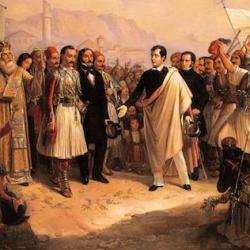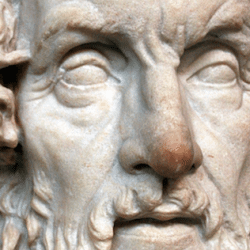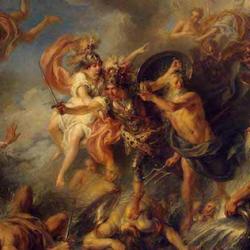When an Athenian father introduced his child to the phratry, the child had to go through a purification rite. In various occasions, places also had to be purified. Robert Parker describes the purification rites ( On Greek Religion (Cornell Studies in Classical Philology) , 158-9):
“Purification was performed with the blood of a small animal, a piglet, lamb, or puppy (or occasionally a bird). To purify a place such as a temple or the Athenian assembly, the bleeding corpse of a piglet was carried around it; ti purify people, the blood was poured over their hands. An army was purified by dividing a dog’s corpse in two and marching it between the two halves. Individuals suspecting bewitchment or other misfortune could have themselves ‘purified around with a puppy’ or ‘puppied around’; we do not know the exact procedure, but it surely entailed the animal’s death. In the one elaborate literary account that we possess of the purification of a murderer, the blood rite was followed by offerings and invocations to Zeus of Purification and the Erinyes; the whole procedure is described by a word from the thu – root . . . but the killing itself has no named addressee, is accompanied by no prayer, and is not described as a sacrifice.”
Pigs and sheep were sacrificial animals, but puppies were common for purification:
“Dogs were apparently reserved for purifications and other slaughter-sacrifices. Spartan ephebes killed puppies for Enyalios immediately before a mock battle, and it was a widespread custom to ‘carry out [the corpses of’ dogs for Hecate to the crossroads,’ as a way of keeping the dangerous goddess at a distance. Why puppies were also killed for goddesses of birth is unclear, but analogy with the other cases suggests that they will not have been eaten.”
For the Greeks, “the power resides in the killing itself. Specific direction can be given by the manipulation of the body: it is carried around the area it is supposed to protect or purify, or it is cut in half and walked through; it is cut up to prefigure the fate of perjurers; it is thrown into an underground pit as a fertilizing agent; in murder purification, the blood is treated as a king of washing agent, ‘purifying blood with blood.’”
Blood not only cleanses but staves off danger: “one kills a black lamb to a typhoon in the hope of making it stop blowing, now.” Oaths are made over dead animals, and everyone has to touch the animal. Before battles, sacrifices were offered, but Parker notes that the meaning is ambiguous: “Was it ‘As we kill this goat, so let us kill the enemy,’ or ‘Take this animal and spare us,’ or neither of these things?”
In any case, Greeks like Jews believed that without blood there is no purification. The letter to the Hebrews could just as well have been addressed to the Greeks.











